Introduction
Low Impact Development (LID) is a sustainable approach to stormwater management that minimizes impacts on waterways. Vegetated swales and buffer strips are types of LID stormwater treatment systems that use soil and plants to filter pollutants from runoff. They are easy to construct and can be used to treat runoff from parking lots, buildings, roadways and homes. It is important to recognize the difference between a ditch and a swale.
Ditches are excavated channels that are constructed to convey stormwater or irrigation water. Ditches are not constructed to provide water quality benefits.
Swales, sometimes called bioswales, are shallow, gently sloped vegetated open channels that slow down runoff, filter out stormwater pollutants and allow some infiltration to occur. They can be designed as a form of bioretention (see LID in Northern Nevada: Bioretention, FS-09-25) and can also be used to convey stormwater runoff in place of pipes or ditches.
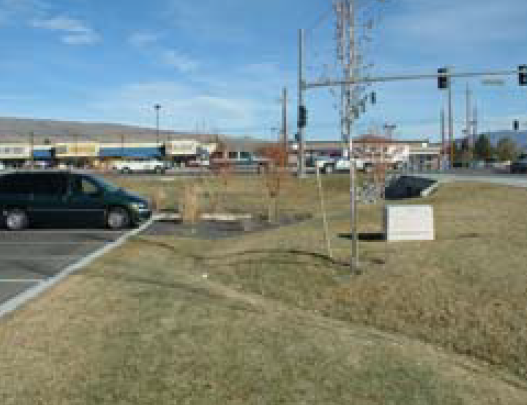
This grassy swale in Carson City receives. Image by Susan Donaldson.
As water flows along the swale, it is slowed down by the plants and the roughness of the landscaped surface. This allows sediments and pollutants to drop out and be processed by the plants and soil. Some stormwater soaks into the soil and is used by plants, and, depending on existing soil conditions and LID design, some stormwater infiltrates and provides groundwater recharge. Some water continues to flow downhill in the swale, but at a slower rate and sometimes at a lower volume than would flow through conventional storm pipes. Vegetated swales are most effective when integrated into the overall site design and can be used to help fulfill new development landscaping requirements.
To provide time for pollutant removal, the minimum length of a swale should be about 100 feet and the channel slope should be between 0.5 and 2.5 percent. If the site has steeper slopes, check dams can be used to maintain a 2.5 percent or less channel slope. With increasing swale length, there is more time to slow the flow of runoff and filter out pollutants. Swales can be designed to incorporate existing natural drainage channels, allowing enhanced recharge, or they can be constructed at the edges of roads, parking lots and developments. Poorly drained soils, such as clays, will require installation of underdrains.
Swales traditionally have been planted with grasses, requiring regular irrigation. If planted with drought-tolerant vegetation, swales will require little to no water once established. In Nevada, swales designed as dry stream channels with rock and native grasses and shrubs are often appropriate, attractive and conserve water in addition to providing urban stormwater treatment.
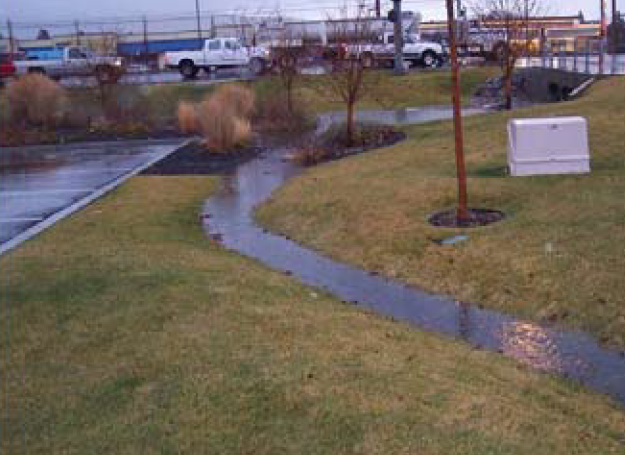
Infiltrates runoff from the parking lot. Image by Chris Conway.
Buffer strips, sometimes called filter strips or biofilters, are gently sloped areas of vegetation and landscaping installed between or at the edge of impervious surfaces and turf areas. Stormwater runoff from sidewalks, driveways and streets, and irrigation overspray from turf areas is captured and filtered through vegetated buffer strips instead of draining onto the street.
A turf or lawn buffer is an area of vegetation and landscaping located between a lawn and any pavement or cement surface that can be watered without the use of sprinklers. Often, the buffer will be found between the front yard lawn and the sidewalk or street. In many cases, lawn areas have been constructed to drain to the sidewalk or the street. If this is the case, a buffer strip can accomplish two purposes: it will capture overspray and interrupt any runoff from the lawn.
Buffer strips are most effective when planted with drought-tolerant vegetation that requires minimal watering. They should be installed over soils that have adequate infiltration rates (see LID in Northern Nevada: Soil Considerations, FS-09-23) and the slope of the buffer strip soil surface should not exceed 4 percent. The flow entering a buffer strip should not be channelized and concentrated, but should spread out across width of the buffer strip to maximize filtering and infiltration. Flow spreaders, such as gravel-filled trenches, are sometimes necessary to distribute flow evenly across a buffer strip.
The steps to installing a lawn buffer strip in an existing development include rerouting the lawn sprinkler system to the new lawn edge to create space for the buffer. For small areas, consider replacing the entire side lawn, as these small areas are virtually impossible to irrigate with sprinklers without wasting water and creating runoff. Remove the turf, amend the existing soils as necessary to allow infiltration, add a drip system or soaker hoses, install plants, and cover the area with rock or mulch. Placing landscape fabric under the rock or mulch will help control weeds. Substantial savings can result from replacing lawn areas with low-water-use vegetation.
If the buffer strip area slopes more than 4 percent, add terraces to create gently sloping areas that effectively capture and infiltrate runoff and support vegetation.
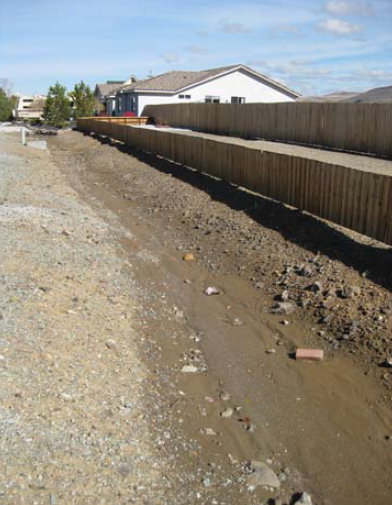
Ditches lack vegetation to help filter pollutants and stabilize soils. Image by Susan Donaldson.
Benefits of Swales and Buffers
- FILTER stormwater runoff
- TRAP particulate pollutants
- SLOW stormwater flows and reduce volumes
- REDUCE soil erosion
- SAVE money by decreasing irrigation needs, as compared to turf
- PROVIDE aesthetic appeal
Buffers can save water by decreasing runoff and overspray
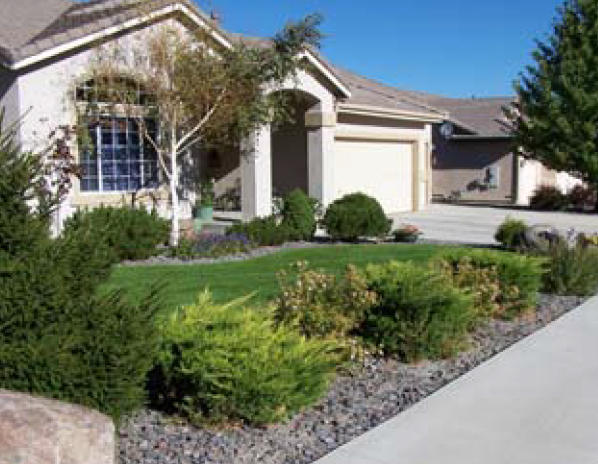
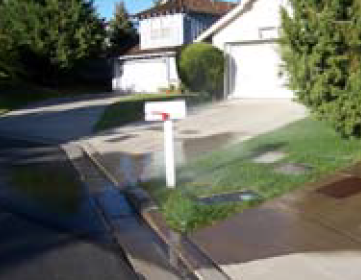
It’s especially difficult to use sprinklers to irrigate small areas such as this one without creating runoff. Often, much water is wasted. Buffers can be constructed between the sidewalk and lawn (left photo). Select low-water-use plants that can be irrigated using drip systems to save money, as well as decrease runoff. It’s very difficult to avoid overspray and runoff when sloping lawns end at the sidewalk or the street (right photo). Images by Susan Donaldson.
For a description of various Low Impact Development practices
consult the following Fact Sheets in the “Low Impact Development in Northern Nevada” series:
- LID: An Introduction, FS-09-22
- Soil Considerations, FS-09-23
- Rainwater Harvesting, FS-09-24
- Bioretention, FS-09-25
- Vegetated Swales and Buffers, FS-09-26
- Green Roofs, FS-09-27
- Plant Materials, FS-09-28
- Porous Pavement, FS-09-29
- Roadway and Parking Lot Design, FS-09-30
- Maintenance, FS-09-31
Plants for vegetated swales and buffers
Plants for vegetated swales and buffer strips should meet the following criteria:
- Native or well-adapted to the local climate
- Low water use
- Low fertilizer requirements
- Minimal maintenance
- Attractive in all seasons
Plant species that are located in the lowest zone of vegetated swales must be able to withstand periodic flooding. Turf can also be used in vegetated swales and buffer strips. However, turf requires regular irrigation, fertilizer application and maintenance, which may result in reduced pollutant removal effectiveness. Densely planted native bunch grasses maintained at a height of 4 to 6 inches are recommended for maximum pollutant removal effectiveness. See LID in Northern Nevada: Plant Materials, FS-09-28, for a list of recommended plants for various LID practices, including vegetated swales and buffer strips.
Maintenance
Grassy swales need standard maintenance including irrigation, mowing, removal of debris, aeration and reseeding. Mow 4 to 6 inches high to avoid drought stress and decrease flow velocities. Monitor swales and buffer strips and adjust irrigation to meet plant water demands while avoiding seepage and runoff. Any standing water remaining after a storm should infiltrate or evaporate within 48 hours to avoid mosquito breeding.
Monitor swales and buffer strips on a regular basis, especially after intense rainstorms, for damage to vegetation, erosion, sediment accumulation and ponded water. Periodic removal of accumulated sediments will be required, as will trash collection. Replace plants and repair eroded areas as needed.
To avoid adding nutrients to stormwater runoff, fertilizer use should be minimized in vegetated swales and buffer strips. Test the soil to determine actual fertilizer needs, and select well-adapted plant species with minimal fertilization requirements. After fertilization, irrigate in short cycles to avoid runoff, and don’t fertilize when rain is expected. The use of well-adapted plant species will also allow minimal use of pesticides. Use mulch, landscape fabric and hand-pulling to control weeds.
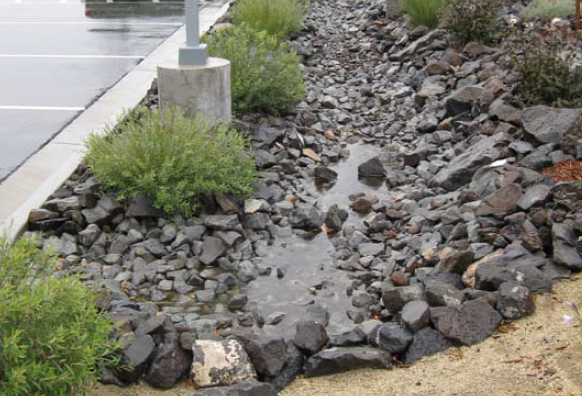
Some swales are lined with rock and have limited plant material. This makes it more difficult to remove accumulated sediment, and decreases pollutant processing by plants. Primary benefits include water retention/ infiltration and sediment removal. Image by Melody Hefner.
Good places for swales and buffers
- Along streets and highways
- Within street medians
- Within and along the edges of parking lots
- At the edges of lawns
For additional detailed planning and design information
refer to the latest versions of the Truckee Meadows Low Impact Development Handbook and the Truckee Meadows Structural Controls Design Manual available at TMS.
LID is used because it is:
- EFFECTIVE in reducing and treating urban runoff
- ECONOMICAL, when less infrastructure is required for LID practices than for traditional stormwater features
- SIMPLE! Most LID features are not highly engineered, expensive or elaborate
- FLEXIBLE and customized for each site
- USEFUL in achieving multiple objectives: stormwater management, landscape beautification, habitat improvement, open space connectivity, etc.
- DESIRABLE, because it adds value when the landscape features used to achieve LID goals are also aesthetically pleasing. This can increase property values.
Technical review provided by Chris Conway, Certified Professional in Sediment and Erosion Control.
Additional information about vegetated swales and buffers can be found at:
- U.S. Environmental Protection Agency, 1999, Stormwater Technology Fact Sheet, Vegetated Swales, 832-F-99-006, www.epa.gov/owm/mtb/vegswale.pdf
- LID Strategies and Tools for NPDES Phase II Communities, Vegetated Swales, www.lowimpactdevelopment.org/lidphase2/swales.htm
- California Stormwater BMP Handbook, New Development and Redevelopment, Vegetated Swale, TC-30, www.cabmphandbooks.com/Documents/Development/TC-30.pdf
Donaldson, S.
2009,
Low Impact Development in Northern Nevada: Vegetated Swales and Buffers,
Extension | University of Nevada, Reno, FS-09-26


